Following the previous Bitcoin analysis ( https://www.gomarkets.com/au/articles/economic-updates/bitcoin-usd-technical-analysis/ ), bitcoin continues to break below pattern after pattern, recently breaking out and re-testing a descending flag pattern on a 4h time frame as seen below: With the next major support sitting around $17,619, it won’t be a surprise if bitcoin comes down to that area. Looking at the correlation between Bitcoin and Ethereum, the last 7 days of price action shows a correlation of.89, which is a positive value that indicates a positive correlation between the two. A positive correlation means that the two moves very similar to one another. [caption id="attachment_273298" align="alignnone" width="602"] (https://cryptowat.ch/correlations)[/caption] [caption id="attachment_273299" align="alignnone" width="527"] (https://cryptowat.ch/correlations)[/caption] For ETHUSD (Ethereum), making similar patterns to BTCUSD, has also recently broken out of a descending flag pattern, signalling a probable continuation of the 4h downtrend, there is a high probability of ETHUSD reaching the next major support around $1012.
More downside for major cryptos?

Related Articles
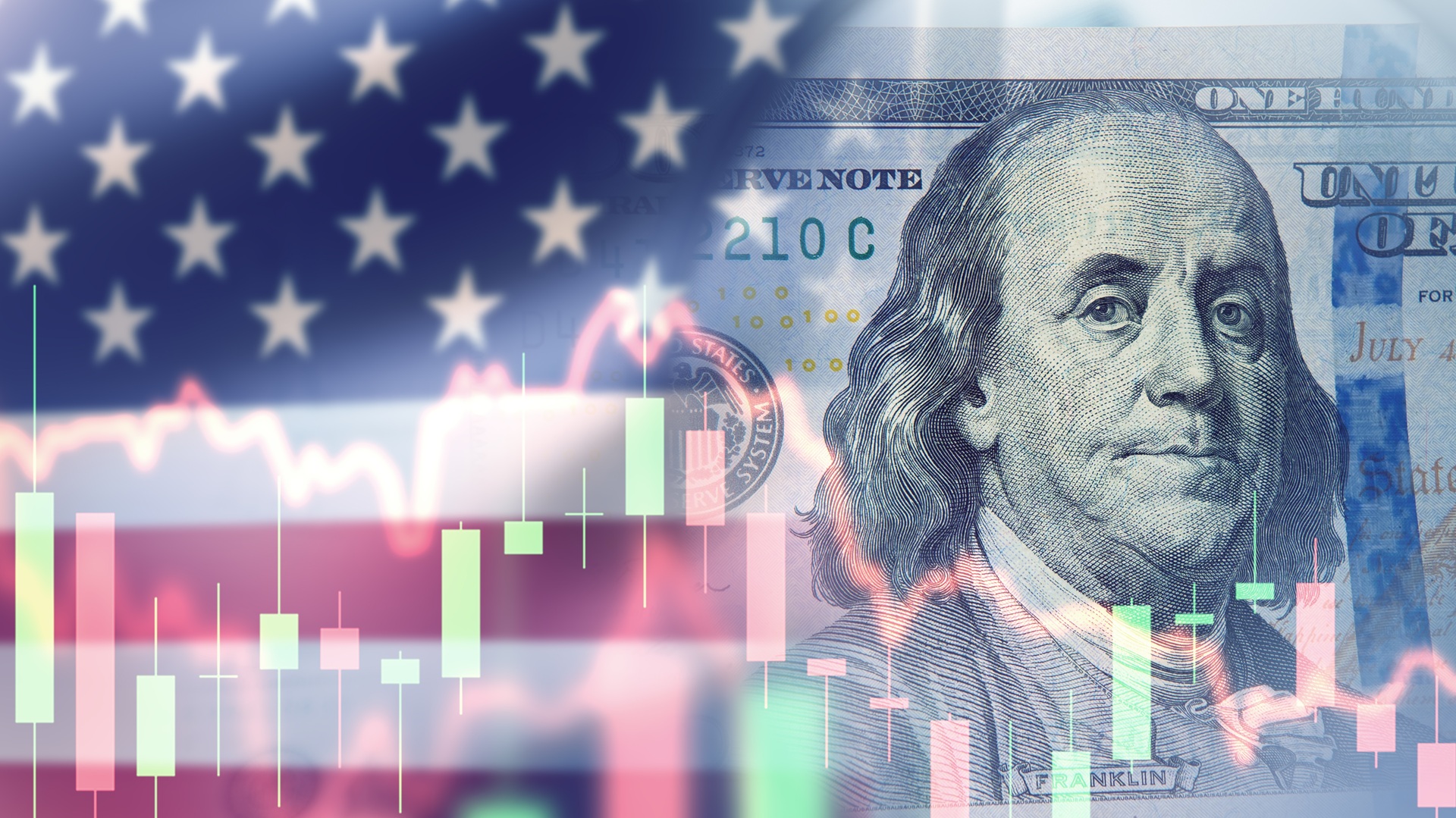
2025 has seen a material decline in the fortunes of the greenback. A technical structure breakdown early in the year was followed by a breach of the 200-day moving average (MA) at the end of Q1. The index then entered correction territory, printing a three-year low at the end of Q2.
Since then, we have seen attempts to build a technical base, including a re-test of the end-of-June lows in mid-September. However, buying pressure has not been strong enough to push price back above the technically critical and psychologically important 100 level.
What the levels suggest from here
As things stand, the index remains more than 10% lower for 2025. On this technical view, the index may revisit the 96 area. However, technical levels can fail and outcomes depend on multiple factors.
US dollar index
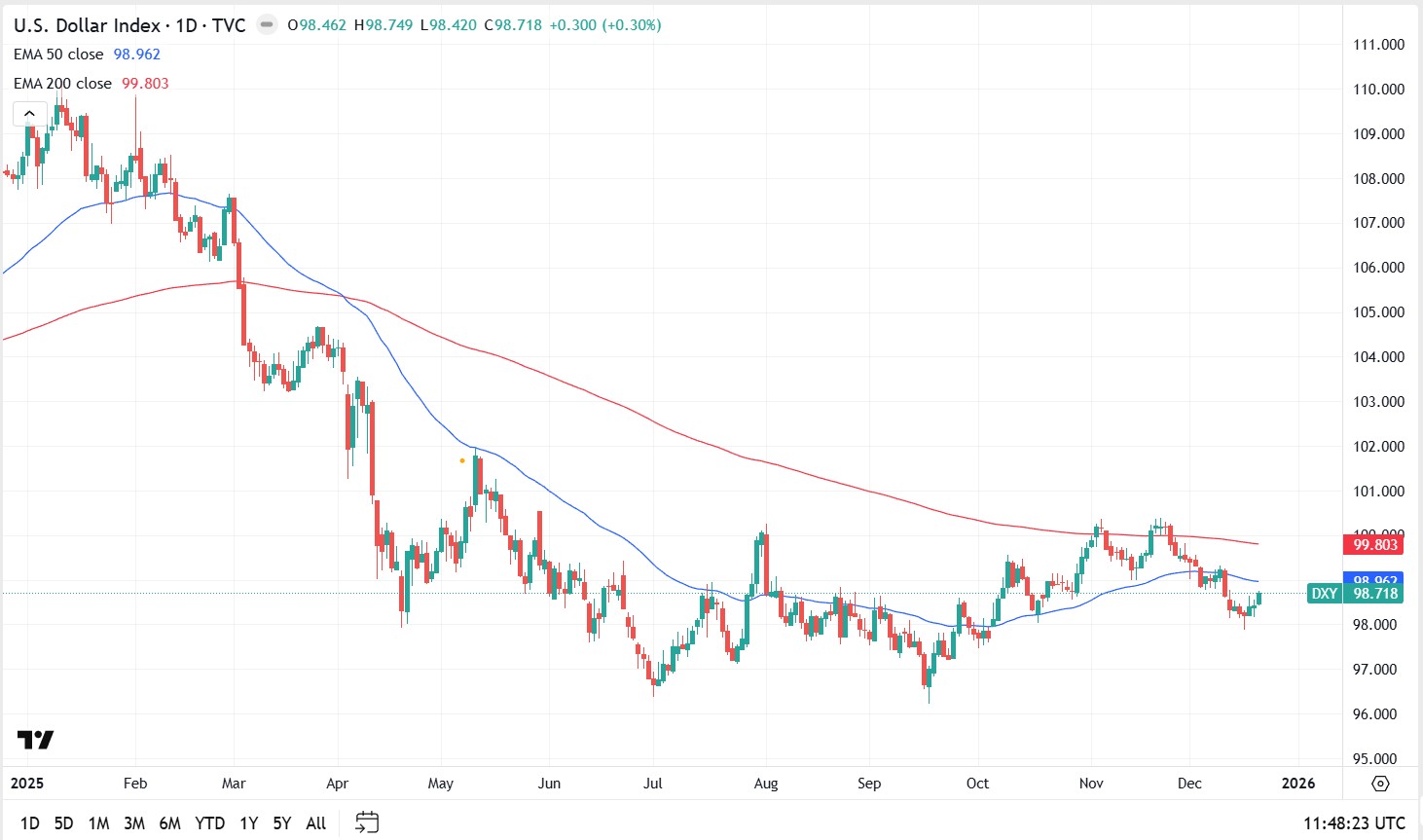
The key question for 2026
The key question remains: are we likely to see further losses in the early part of next year and beyond, or will current support hold?
We cannot assess the US dollar in isolation and any outlook is shaped by internal and global factors, not least its relative strength versus other major currencies. Many of these drivers are interrelated, but four potential headwinds stand out for any US dollar recovery. Collectively, they may keep downside pressure in play.
Four headwinds for any US dollar recovery
1. The US dollar as a safe-haven trade
One scenario where US dollar support has historically been evident is during major global events, slowdowns and market shocks. However, the more muted response of the US dollar during risk-off episodes this year suggests a shift away from the historical norm, with fewer sustained US dollar rallies.
Instead, throughout 2025, some investors appeared to favour gold, and at other times, FX and even equities, rather than into the US dollar. If this change in behaviour persists through 2026, it could make recovery harder, even if global economic pressure builds over the year ahead.
2. US versus global trade
Trade policy is harder to measure objectively, and outcomes can be difficult to predict. That said, trade battles driven by tariffs on US imports are often viewed as an additional potential drag on the US dollar.
The impact may be twofold if additional strain is placed on the US economy through:
- a slowdown in global trade volumes as impacted countries seek alternative trade relationships, with supply chain distortions that may not favour US growth
- pressure on US corporate profit margins as tariffs lift costs for importers
3. Removal of quantitative tightening
The Fed formally halted its balance sheet reduction, quantitative tightening (QT), as of 1 December 2025, ending a program that shrank assets by roughly US$2.4 trillion since mid-2022.
Traditionally, ending QT is seen as marginally negative for the US dollar because it stops the withdrawal of liquidity, can ease global funding conditions, and may reduce the scarcity that can support dollar demand. Put simply, more dollars in the system can soften the currency’s support at the margin, although outcomes have varied historically and often depend on broader financial conditions.
4. Interest rate differential
Interest rate differential (IRD) is likely to be a primary driver of US dollar strength, or otherwise, in the months ahead. The latest FOMC meeting delivered the expected 0.25% cut, with attention on guidance for what may come next.
Even after a softer-than-expected CPI print, markets have been reluctant to price aggressive near-term easing. At the time of writing, less than a 20% chance of a January cut is priced in, and it may be March before we see the next move.
The Fed is balancing sticky inflation against a jobs market under pressure, with the headline rate back at levels last seen in 2012. The practical takeaway is that a more accommodative stance may add to downward pressure on the US dollar.
Current expectations imply around two rate cuts through 2026, with the potential for further easing beyond that, broadly consistent with the median projections shown in the chart below. These are forecasts rather than guarantees, and they can shift as economic data and policy guidance evolve.
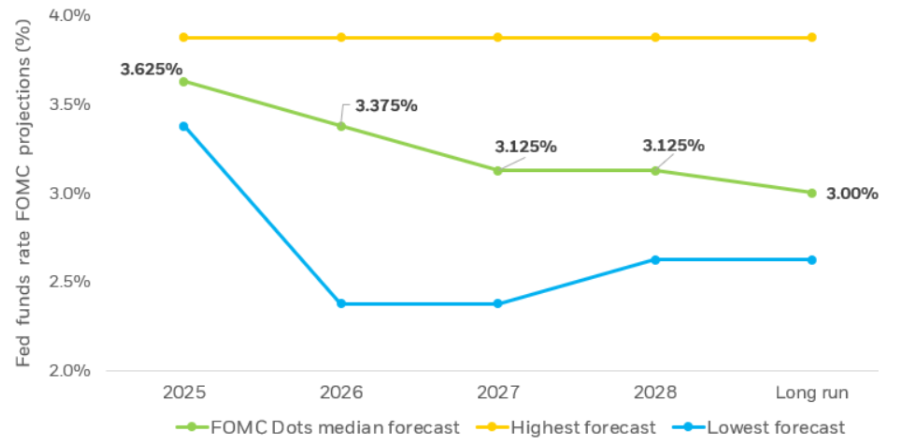

The “Magnificent Seven” technology companies are expected to invest a combined $385 billion into AI by the end of 2025.
Microsoft is positioning itself as the platform leader. Nvidia dominates the underlying AI infra. Google leads in research. Meta is building open-source tech. Amazon – AI agents. Apple — on-device integration. And Tesla pioneering autonomous vehicles and robots.
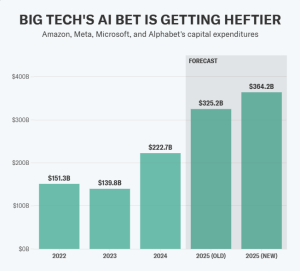
With such enormous sums pouring into AI, is this a winner-take-all game?
Or will each of the Mag Seven be able to thrive in the AI future?
Microsoft: The AI Everywhere Strategy
Microsoft has made one of the biggest bets on AI out of the Mag Seven — adopting the philosophy that AI should be everywhere.
Through its deep partnership with OpenAI, of which it is a 49% shareholder, the company has integrated GPT-5 across its entire ecosystem.
Key initiatives:
- GPT-5 integration across consumer, enterprise, and developer tools through Microsoft 365 Copilot, GitHub Copilot, and Azure AI Foundry
- Azure AI Foundry for unified AI development platform with model router technology
- Copilot ecosystem spanning productivity, coding, and enterprise applications with real-time model selection
- $100 billion projected AI infrastructure spending for 2025
Microsoft’s centrepiece is Copilot, which can now detect whether a prompt requires advanced reasoning and route to GPT-5's deeper reasoning model.
This (theoretically) means high-quality AI outputs become invisible infrastructure rather than a skill users need to learn.
However, this all-in bet on OpenAI does come with some risks. It is putting all its eggs in OpenAI's basket, tying its future success to a single partnership.

Elon Musk warned that "OpenAI is going to eat Microsoft alive"[/caption]
Google: The Research Strategy
Google’s approach is to fund research to build the most intelligent models possible. This research-first strategy creates a pipeline from scientific discovery to commercial products — what it hopes will give it an edge in the AI race.
Key initiatives:
- Over 4 million developers building with Gemini 2.5 Pro and Flash
- Ironwood TPU offering 3,600 times better performance compared to Google’s first TPU
- AI search overviews reaching 2 billion monthly users across Google Search
- DeepMind breakthroughs: AlphaEvolve for algorithm discovery, Aeneas for ancient text interpretation, AlphaQubit for quantum error detection, and AI co-scientist systems
Google’s AI research branch, DeepMind, brings together two of the world's leading AI research labs — Google Brain and DeepMind — the former having invented the Transformer architecture that underpins almost all modern large language models.
The bet is that breakthrough research in areas like quantum computing, protein folding, and mathematical reasoning will translate into a competitive advantage for Google.
Today, we're introducing AlphaEarth Foundations from @GoogleDeepMind , an AI model that functions like a virtual satellite which helps scientists make informed decisions on critical issues like food security, deforestation, and water resources. AlphaEarth Foundations provides a… pic.twitter.com/L1rk2Z5DKk
— Google AI (@GoogleAI) July 30, 2025
Meta: The Open Source Strategy
Meta has made a somewhat contrarian bet in its approach to AI: giving away their tech for free. The company's Llama 4 models, including recently released Scout and Maverick, are the first natively multi-modal open-weight models available.
Key initiatives:
- Llama 4 Scout and Maverick - first open-weight natively multi-modal models
- AI Studio that enables the creation of hundreds of thousands of AI characters
- $65-72 billion projected AI infrastructure spending for 2025
This open-source strategy directly challenges the closed-source big players like GPT and Claude. By making AI models freely available, Meta is essentially commoditizing what competitors are trying to monetize. Meta's bet is that if AI models become commoditized, the real value will be in the infrastructure that sits on top. Meta's social platforms and massive user base give it a natural advantage if this eventuates.
Meta's recent quarter was also "the best example to date of AI having a tangible impact on revenue and earnings growth at scale," according to tech analyst Gene Munster.

However, it hasn’t been all smooth sailing for Meta. Their most anticipated release, Llama Behemoth, has all but been scrapped due to performance issues. And Meta is now rumored to be developing a closed-source Behemoth alternative, despite their open-source mantra.
Amazon: The AI Agent Strategy
Amazon’s strategy is to build the infrastructure for AI that can take actions — booking meetings, processing orders, managing workflows, and integrating with enterprise systems.
Rather than building the best AI model, Amazon has focused its efforts on becoming the platform where all AI models live.
Key initiatives:
- Amazon Bedrock offering 100+ foundation models from leading AI companies, including OpenAI models.
- $100 million additional investment in AWS Generative AI Innovation Center for agentic AI development
- Amazon Bedrock AgentCore enabling deployment and scaling of AI agents with enterprise-grade security
- $118 billion projected AI infrastructure spending for 2025
The goal is to become the “orchestrator” that lets companies mix and match the best models for different tasks.
Amazon’s AgentCore will provide the underlying memory management, identity controls, and tool integration needed for these companies to deploy AI agents safely at scale.
This approach offers flexibility, but does carry some risks. Amazon is essentially positioning itself as the middleman for AI. If AI models become commoditized or if companies prefer direct relationships with AI providers, Amazon's systems could become redundant.
Nvidia: The Infra Strategy
Nvidia is the one selling the shovels for the AI gold rush. While others in the Mag Seven battle to build the best AI models and applications, Nvidia provides the fundamental computing infrastructure that makes all their efforts possible.
This hardware-first strategy means Nvidia wins regardless of which company ultimately dominates. As AI advances and models get larger, demand for Nvidia's chips only increases.
Key initiatives:
- Blackwell architecture achieving $11 billion in Q2 2025 revenue, the fastest product ramp in company history
- New chip roadmap: Blackwell Ultra (H2 2025), Vera Rubin (H2 2026), Rubin Ultra (H2 2027)
- Data center revenue reaching $35.6 billion in Q2, representing 91% of total company sales
- Manufacturing scale-up with 350 plants producing 1.5 million components for Blackwell chips
With an announced product roadmap of Blackwell Ultra (2025), Vera Rubin (2026), and Rubin Ultra (2027), Nvidia has created a system where the AI industry must continuously upgrade to Nvidia’s newest tech to stay competitive.
This also means that Nvidia, unlike the others in the Mag Seven, has almost no direct AI spending — it is the one selling, not buying.
However, Nvidia is not indestructible. The company recently halted its H20 chip production after the Chinese government effectively blocked the chip, which was intended as a workaround to U.S. export controls.
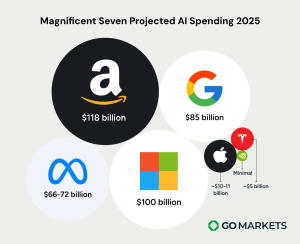
Apple: The On-Device Strategy
Apple's AI strategy is focused on privacy, integration, and user experience. Apple Intelligence, the AI system built into iOS, uses on-device processing and Private Cloud Compute to help ensure user data is protected when using AI.
Key initiatives:
- Apple Intelligence with multi-model on-device processing and Private Cloud Compute
- Enhanced Siri with natural language understanding and ChatGPT integration for complex queries
- Direct developer access to on-device foundation models, enabling offline AI capabilities
- $10-11 billion projected AI infrastructure spending for 2025
The drawback of this on-device approach is that it requires powerful hardware from the user's end. Apple Intelligence can only run on devices with a minimum of 8GB RAM, creating a powerful upgrade cycle for Apple but excluding many existing users.
Tesla: The Robo Strategy
Tesla's AI strategy focuses on two moonshot applications: Full Self-Driving vehicles and humanoid robots.
This is the 'AI in the physical world' play. While others in the Mag Seven are focused on the digital side of AI, Tesla is building machines that use AI for physical operations.
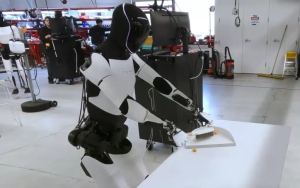
Key initiatives:
- Plans for 5,000-10,000 Optimus robots in 2025, scaling to 50,000 in 2026
- Robotaxi service targeting availability to half the U.S. population by EOY 2025
- AI6 chip development with Samsung for unified training across vehicles, robots, and data centers
- $5 billion projected AI infrastructure spending for 2025
This play is exponentially harder to develop than digital AI, and the markets have reflected low confidence that Tesla can pull it off.
TSLA has been the worst-performing Mag Seven stock of 2025, down 18.37% in H1 2025.
However, if Tesla’s strategy is successful, it could be far more valuable than other AI plays. Robots and autonomous vehicles could perform actual labour worth trillions of dollars annually.
The $385 billion Question
The Mag Seven are starting to see real revenue come in from their AI investments. But they're pouring that money (and more) back into AI, betting that the boom is just getting started.
The platform players like Microsoft and Amazon are betting on becoming essential infrastructure. Nvidia’s play is to sell the underlying hardware to everyone. Google and Meta compete on capability and access. While Apple and Tesla target specific use cases.
The $385 billion question is which of the Magnificent Seven has bet the right way? Or will a new player rise and usurp the long-standing tech giants altogether?
You can access all Magnificent Seven stocks and thousands of other Share CFDs on GO Markets.

Over the past 3 months Nvidia has moved through ranges that some stocks don’t do in years, in some cases decades. Having lost over 35 per cent in the June to August sell off, it quickly bounced over 40 per cent in the preceding 20 days once it hit its August low as we build positions ahead of its results. These results delivered Nvidia style numbers with three figure growth on the sales, net profit and earnings lines but this did not appease the market, seeing it fall 22 per cent in a little over 8 days.
Which brings us to now – a new 16 per cent drive as Nivida reports it’s struggling to meet demands and that the AI revolution is translating faster than even it expected. This got us thinking – Where are we right “Now” in the AU players? Thus, it’s time to dive into the drivers for the Nvidia and Co.
AI players. Supersonic As mentioned, Nvidia’s results have been astonishing – and it still has time to do a US$50 billion buyback. It collected the award for becoming the world’s largest company in the shortest timeframe in the post-WWII era, think about that for one second – that’s faster than Amazon, Microsoft, Apple, Google, Shell, BP, ExxonMobil, TV players of the 60s and 70s.
So the question is how does it keep its speed and trajectory? Well that comes from what some are calling the ‘supersonic’ scalers. These are the players like Google, Amazon, Meta and Microsoft that are the users and providers of the AI revolution.
These are the players that have spent hundreds billions thus far on the third digital revolution. Let us once again put that into perspective, the amount of spending is (inflation adjusted) the same as what was spent during the 1960’s on mainframe computing and the 1990’s distribution of fibre-optics. So we have now seen that level of spending in AI the next step is ‘usage’ and that is the inflection point we find ourselves at.
Currently AI is mainly used to train foundational models and chatbots – which is fine but not long-term financially stable. It needs to move into things like productions – that is producing models for corporate clients that forecast, streamline and increase productivity. This is the ‘Grail’ This immediately raises the bigger question for now – can this Grail be achieved?
The Voices To answer that – let us present some arguments from some of AI’s largest “Voices” On the AI potential and the possibility of a profound and rapid technological revolution, Sam Altman, CEO of OpenAI, has claimed that AI represents the "biggest, best, and most important of all technology revolutions," and predicts that AI will become increasingly integrated into all aspects of life. This reflects a belief in AI's far-reaching influence over time. The never subtle McKinsey and Co. has projected that generative AI could eventually contribute up to $8 trillion to the global economy annually.
This figure underscores the massive economic potential of AI. The huge caveat: McKinsey's predictions are never real-world tested and inevitably fall flat in the market. This kind of money is what makes AI so attractive to players in Venture Capital.
For the VC watchers out there the one that is catching everyone’s attention is VC accelerator Y Combinator which is fully embracing the technology. Just to put Y Combinator into context, according to Jared Heyman’s Rebel Fund, if anyone had invested in every Y Combinator deal since 2005 (which would have been impossible just to let you know), the average annual return would have been 176%, even after accounting for dilution. Furthermore to the VC story - AI has accounted for over 40 per cent of new unicorns (startups valued at $1 billion or more) in the first half of 2024, and 60 per cent of the increase in VC-backed valuations.
So far in 2024, U.S. unicorn valuations have grown by $162 billion, largely driven by AI’s rapid expansion, according to Pitchbook data. So the Voices certainly believe it can be achieved. But is this a good thing?
The Good, the Bad and the Ugly AI is advancing at such a rapid pace that existing performance benchmarks, such as reading comprehension, image classification and advanced maths, are becoming outdated, necessitating the creation of new standards. This reflects the fast-moving nature of AI progress. For example, look at the success of AlphaFold, an AI-driven algorithm that accurately predicts protein structures.
Some see this as one of the most important achievements in AI’s short history and underscores AI’s transformative impact on science, particularly in fields like biology and healthcare. This is the Good. Then there is the 165-page paper titled "Situational Awareness" by Aschenbrenner which has predicted that by 2030, AI will achieve superintelligence and create a $1 trillion industry.
Also, a positive, but will consume 20 per cent of the U.S. power supply. These incredible predictions emphasise the enormous scale of AI and the impact it will have on industry, infrastructure and people. The latest Google study found that generative AI could significantly improve workforce productivity.
The study suggests that roughly 80 per cent of jobs could see at least 10 per cent of tasks completed twice as fast due to AI, which has implications for industries such as call centres, coding, and professional writing. This highlights AI's capacity to streamline tasks and enhance efficiency across various fields. However it also raises the massive concern around job security, job satisfaction and the socio-economic divide as the majority of those affected by AI ‘productivity’ are in mid to low scales.
Then we come to Elon Musk’s new AI startup, xAI, which raised $6 billion at a valuation of $24 billion this year. The company is planning to build the world’s largest supercomputer in Tennessee to support AI training and inference. This all sounds economically and financially exciting but it has a darker side.
These are the kinds of AI ventures that have seen ‘deep-fake’ creations. For example Musk himself shared a deep-fake video of Vice President Kamala Harris. This is the ugly side of AI and reflects the broader cultural and ethical issues surrounding AI-generated content.
Furthermore – we should always be forecasting both the good and the bad for investment opportunities. These issues are already attracting regulations and compliance responses. How impactful will these be?
And will it halt the AI driven share price appreciation? It is a very real and present issue. Where does this leave us?
The share price future of Nvidia and Co is clearly dependent on the longer-term achievement of the AI revolution. As shown, the supersonic players in technology and venture capital are betting big on AI, with predictions that it will reshape the global economy, industries, and even basic societal structures. However, there is still uncertainty about the exact timeline for these changes and how accurately the market is pricing in AI's potential.
The AI ecosystem is moving at breakneck speed, with new developments outpacing benchmarks and productivity gains reshaping jobs, but whether all these projections that range from trillion-dollar economies to superintelligence materialises remains to be seen. Thus – for now – Nvidia and Co’s recent roller-coaster trading looks set to continue.
Recent Articles
.jpg)
一、全球及澳大利亚金融状况概览:
在本次会议上,委员们回顾了全球及澳大利亚的金融状况。近期全球科技股估值过高引发市场波动,股票价格一度下跌后反弹,美国市场受预期宽松货币政策支撑,而澳大利亚股市下跌持续更久,反映市场对现金利率上升和部分板块估值调整。全球债市利差仍低,但部分国家公司债收益率上升。利率预期方面,美联储预计降息并延续宽松,欧洲央行维持利率,加拿大、新西兰、瑞典和澳大利亚可能上调,日本则在通胀压力下逐步加息。澳大利亚短期债券收益率上升,但澳元仅小幅升值,缓解金融紧缩压力。国内方面,抵押贷款支出高企,家庭储蓄率维持高位,信贷需求回升,企业债务占GDP比重恢复至疫情前水平,显示金融状况喜忧参半。
二、经济增长与通胀趋势:
委员们对国内经济增长与通胀趋势进行了评估。10月年度CPI升至3.8%,部分因电费补贴停止,新房成本、市场服务、耐用品及国内旅行价格均高于预期,短期通胀前景上行风险增加,但数据波动性较大,需继续观察。劳动力市场方面,失业率上升趋势已在10月得到控制,其他未充分利用劳动力指标维持低水平,企业招聘仍有困难,但工资价格指数总体稳定,公共部门工资增长抵消私营部门放缓,整体略显紧张。经济增长方面,截至9月季度GDP增速接近潜在水平,私人需求增长强劲,数据中心和住房投资为主要动力,宽松政策效果预计在2026年显现。产出缺口为正,NAB产能利用率指标显示产能约束高于历史平均水平,表明经济存在一定需求过剩。
三、货币政策考量与决策
在政策讨论中,委员们重点关注三方面:总需求略高于潜在供给,通胀风险上升但持续性仍不明;私人需求复苏将支撑劳动力需求,经济增长动力依然存在;金融环境信号分化,部分委员认为不再紧缩,部分认为仍略紧,需观察债券收益率及利率上升影响。近期CPI及成本端指标显示通胀压力上行,但短期内过度推断趋势存在风险。若通胀持续上行,未来一年可能需加息,但仍需评估金融环境和市场利率对经济的作用。本次会议决定维持现金利率目标3.60%不变,并强调将持续密切关注数据变化及经济前景,在未来会议评估政策调整必要性。董事会重申其使命,致力实现价格稳定和充分就业,并将采取一切必要措施达成目标。
总结:
本次RBA会议表示,金融状况信号分化,利率上升与汇率变动影响尚未完全显现;通胀压力上行但短期持续性不明;劳动力市场略紧,私人需求复苏支撑经济。政策暂按兵不动,未来可能加息,重点关注2026年初通胀数据及金融市场动态。
.jpg)
TradingView编程系列5:循环结构(上)
循环(Loops) 是一种结构,它会根据指定的条件反复执行一段语句块。它们允许脚本在不需要重复编写代码的情况下完成重复性的任务。Pine Script提供了三种不同的循环类型:for、while 和 for…in。
一、隐式循环
Pine Script的执行模型和时间序列结构,使得在许多情况下并不需要写出明显的循环。
当用户将一个 Pine 脚本添加到图表中时,脚本会在一个等同于“大循环”的环境中运行:它会在可用数据中的每一根历史 K 线以及每一个实时 tick 上各执行一次代码。脚本可以通过历史引用运算符(history-referencing operator)访问之前 K 线上的执行结果;而通过使用 var 或 varip 关键字声明的变量,其计算结果可以在多次执行之间保持不变。这些特性使脚本能够通过逐 K 线(bar-by-bar)的计算来完成各种任务,而无需依赖显式的循环。
下面我们来看一个简单的示例,说明在 Pine Script 中不必要地使用循环的情况。

下面按逐行解释这段 Pine Script 代码的含义和执行逻辑:
首先,声明这是一个指标脚本(indicator)。test是指标在图表上显示的名称。overlay = true 表示该指标绘制在主价格图表上。
其次,声明一个整数类型变量名为lengthInput的变量。input.int()为创建一个用户可在参数设置中修改的整数输入项,其中默认值为 20 根 K 线。在参数面板中显示的名称为length。
接下来,再声明一个初始化变量为 0,浮点数类型的变量closeSum。注意,由于没有使用 var 关键字,在每一根 K 线上脚本执行时,closeSum 都会被重新置为 0。
然后进入for循环,对最近的 lengthInput 根 K 线进行循环,将每根 K 线的收盘价累加到 closeSum。在循环体中,把最近 lengthInput 根 K 线的收盘价逐一相加。
再之后,用收盘价总和除以 K 线数量,计算平均值,保存到变量avgClose中。
最后,将数据画成线,其中"Average close"为图例名称,线条颜色为橙色,线条宽度为2。
总结来说,这段代码就是用for循环计算并绘制最近 lengthInput 根 K 线的收盘价平均值。
其实,这个示例的重点在于演示 “不必要的循环”,在 Pine Script 中,这种均值计算可以直接使用内置函数ta.sma,例如:
avgClose = ta.sma(close, lengthInput)
二、显性循环
尽管 Pine 的执行模型、时间序列结构以及可用的内置函数在许多情况下都能消除对循环的需求,但并非所有迭代任务都可以不用循环。在以下几类任务中,循环是必不可少的:
- 遍历或操作集合(如数组、矩阵和映射)
- 执行无法通过无循环表达式或现有内置函数完成的计算
- 回溯历史数据以分析过去的 K 线,而比较所需的参考值仅在当前 K 线上才可用
例如,要判断哪些过去的 K 线的最高价(high)高于当前 K 线的最高价,就必须使用循环。
这是因为:当前 K 线的数值在脚本运行于之前的历史 K 线时是无法获取的。脚本只能在执行到当前 K 线时访问该 K 线的数值,并且必须在这次执行过程中向后回溯历史序列,将之前的数值与当前值进行比较。
例如,下面的脚本使用 for 循环,将之前 lengthInput 根 K 线的最高价与最后一根历史 K 线的最高价进行比较。在循环中,它调用 label.new(),在每一根最高价高于最后一根历史 K 线最高价的过去 K 线上方绘制一个圆形标签:

首先,声明这是一个名为test2的指标脚本。此脚本允许最多绘制 500 个label,否则在绘制大量标签时会触发限制错误。然后设置lengthInput变量,该变量表示要拿多少根过去的 K 线的最高价(high),来和最后一根历史 K 线的最高价比较,1和500为允许输入的最小值和最大值。
接下来,判断当前是否是最后一根已确认的历史 K 线。barstate.islastconfirmedhistory在历史数据的最后一根 K 线时返回 true,在实时 K 线或更早的历史 K 线上返回 false。
在最后一根历史K线的最高价位置画一条水平虚线。其中line.new的前四个参数分别为起点横坐标,起点纵坐标,终点横坐标,终点纵坐标。
接下来进入For循环,首先判断过去某根 K 线的最高价 > 当前(最后历史)K 线的最高价,如果高于,则紫色圆形标签自动绘制在 K 线柱的上方。
最后一行代码,使用三元运算符判断给最后一根历史 K 线上色高亮。如果是最后一根历史 K 线,则为橙色,否则不改变颜色。

可以看到,当我们将长度参数设置为 60 后,图表中会在最高价高于当前 K 线最高价的历史 K 线上方显示紫色圆点,同时还会绘制一条表示当前 K 线最高价的水平虚线,用于直观地标示该参考价位。
综上所述,本文通过示例对比说明了 Pine Script 中“不必要循环”和“必须使用循环”的典型场景。合理理解 Pine 的执行模型,优先使用内置函数,可以提升脚本的简洁性与性能;而在需要基于当前 K 线回溯并分析历史数据时,循环则不可或缺。掌握循环的正确使用方式,有助于编写更高效、清晰且功能强大的 Pine Script 脚本。

What moved the ASX 200 in 2025?
In 2025, the ASX 200 closed around 8,621 points and was up approximately 6% year to date (YTD) as of 19 December close. Market direction was most sensitive to Reserve Bank of Australia (RBA) expectations, commodity prices and China-linked demand, and (to a lesser extent) moves in the Australian dollar (AUD). The index recovered from November’s pullback, but remained below October’s record close.
Key 2025 drivers included:
- RBA policy expectations: Sentiment was shaped by shifting views on the timing and extent of rate moves. The November pullback reflected repricing towards a longer pause and higher uncertainty around whether the next move could be a hike rather than a cut, particularly as jobs and inflation data surprised.
- Resources and China sensitivity: With a meaningful resources weight, the index responded to iron ore stability, strong gold prices and relative firmness in base metals. China data and any perceived policy support (including signals from the People’s Bank of China (PBOC)) remained important for the export backdrop. A relatively stable AUD also reduced currency-related noise for exporters.
- Index composition and market structure: The ASX 200’s heavier tilt to materials and banks, and lower exposure to high-growth technology, meant it often lagged tech-led global rallies, but tended to hold up better when AI and growth valuations were questioned.
- Corporate earnings: Reporting season outcomes influenced valuation support. In September’s half-year reporting season, around 33% of ASX 200 companies beat expectations, which helped underpin pricing around current levels.
Current state
The ASX 200 was roughly 5% below its late-October record high close of 9,094 points. After the November retracement, support around 8,400 appeared to hold and buying interest improved. The 50-day EMA near 8,730 (a prior consolidation area) was a commonly watched near-term reference, noting technical indicators can be unreliable.
What to watch in January
- China and commodity demand: Growth, trade and any fresh stimulus inference from the PBOC may affect sentiment.
- Domestic inflation and labour data: CPI and jobs prints are key inputs into RBA expectations.
- Key levels and follow-through: The post-November rebound may need continued demand to sustain momentum.

What moved the Nikkei 225 in 2025?
In 2025, the Nikkei 225 traded around 39,200 points and was up approximately 21% year to date (YTD). Market direction was most sensitive to moves in the Japanese yen (JPY) and Bank of Japan (BOJ) communication, with the index consolidating after multi-decade highs. While broader signals remained constructive, consolidation can resolve either higher or lower.
Key influences included:
- JPY movements and earnings translation: A weaker JPY can boost the reported value of overseas earnings for some exporters, although it may also increase input and import costs. The net impact often depends on company hedging practices and varies by sector, with effects most evident in export-heavy industries such as automotive, industrials and parts of technology manufacturing.
- Gradual BOJ policy transition: The BOJ continued to step away from ultra-easy settings, but tightening was generally cautious. Markets largely priced a slow, conditional normalisation, which helped limit downside, even as policy headlines created bouts of volatility.
- Corporate governance reforms: Ongoing improvements in capital efficiency and shareholder returns supported interest from overseas investors. Share buybacks, stronger balance-sheet discipline and improved return on equity (ROE) contributed to re-rating in parts of the market.
- Global cyclical exposure: The Nikkei moved with shifts in global manufacturing sentiment and expectations for US growth, particularly during risk-on phases associated with AI-related capital spending.
Current state
After pushing to multi-decade highs earlier in the year, the Nikkei spent time consolidating but has remained structurally strong. Price sits above key long-term moving averages, and some technicians watch the 50-day exponential moving average (EMA) as a potential reference level (noting these indicators can be unreliable). Currency swings and shifting BOJ expectations were commonly cited as contributors to much of the second-half volatility, although pullbacks were generally met with buying interest.
What to watch in January for Japan
- JPY volatility: Sharper yen moves, especially if driven by BOJ or Federal Reserve expectations, could quickly change exporter earnings assumptions.
- BOJ communication: Small changes in language on inflation persistence or bond market operations may move sentiment.
- Global growth data: US and China manufacturing and trade prints remain key inputs for an externally focused economy.



